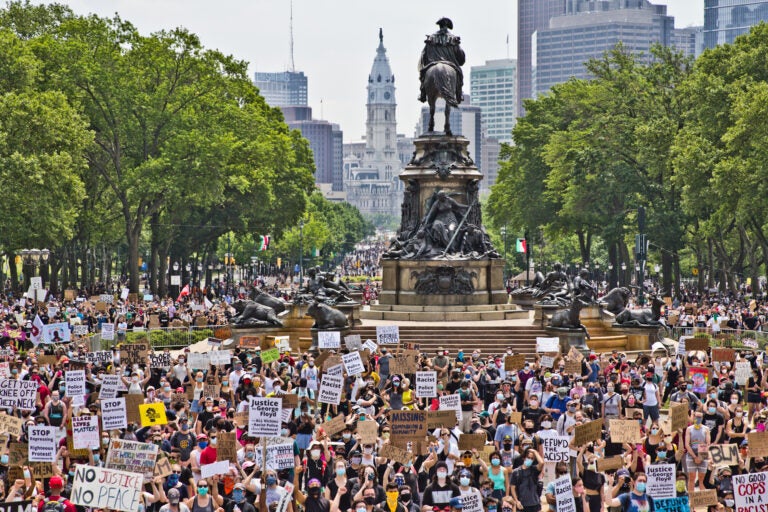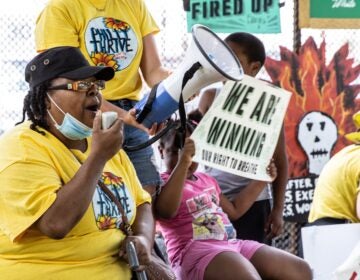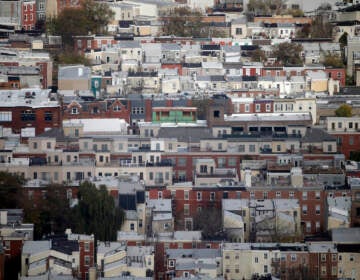White urbanists: let’s use our privilege to advocate for anti-racist design
Urban anthropologist Katrina Johnston-Zimmerman argues that in order for cities to be “human-centered,” white urbanists need to actively be anti-racist.

Demonstrators took over the Benjamin Franklin Parkway demanding an end to police brutality and justice for George Floyd on June 6, 2020. (Kimberly Paynter/WHYY)
When I was a young girl, it never occurred to me that any of my friends would be discriminated against simply because of the color of their skin. And it was never made clear to me by any person or institution that I am benefiting from a system of racism because I am white.
Thirty-plus years later and I find myself an urban anthropologist in the midst of one of the most critical events in our collective human history. It’s a time when people of color, specifically Black people, are not only dying in greater numbers from a global pandemic, but are doing so in addition to the racist risks that come with simply running, shopping, birding — and living — in our cities’ public spaces every day. It didn’t matter that I valued diversity in my friends or appreciated different cultures. None of those good intentions or messages of “color-blindness” was ever going to be enough to rectify centuries of abuse against all of the people I knew and loved growing up.
Now that I know, I recognize that I am complicit unless I am explicitly anti-racist.
It feels shameful now that I was so disconnected from reality for so long that I needed to be taught by other means. I’m furious that this injustice had to go on for so long, costing so many innocent lives, in order to make this point clear for others. And I’m outraged to consider that anyone still needs to be told that we live in a society based on white supremacy and misogyny that oppresses anyone who isn’t white.
But while it’s easy to say that the events of recent days and the ignorance of recent decades breaks my heart, it’s another thing entirely to take action against this injustice. As white urbanists, we need to take a closer look at how we have been advocating for, managing, and building our cities and the ways in which we have been perpetuating an ideal of an equitable city without calling it like it is.
It’s time, as it has been, for anti-racist urbanism
For decades, urbanists in various professions have advocated for different ways to alter the built environment to be happier, healthier, and more human-scale. This often boils down to experts advocating for a “human-centered” city in order to draw attention to the ways in which cities have been built for the scale of the car rather than the human form we used for thousands of years.
But even this terminology is fraught with discrepancies. Which human is the “human” being measured? White? Male? Able-bodied? Cisgender? The urbanists advocating for this are often just that, and are also the ones speaking on the subject, writing bestselling books, and working as leaders in our cities. As such, whether explicitly or implicitly, they are framing this definition based on their experiences as mostly white cisgender men.
And for many of them, equitable urbanism is at the top of their priorities, certainly. But a “city for people” as advocated by a few, runs the risk of creating a city that only perpetuates the status quo. Without calling out the racism underlying the problems that persist in our urban environments, we run the risk of capital improvements at the expense of gentrification, rather than focusing on bettering the city firstly for the people who need it most.
So what would anti-racist urbanism look like? Let’s start with our streets
In the last 100 years, the automobile has dominated our urban form. And in that time, urban planning used the car as a tool to carry out racist and patriarchal ideals. These majority white male planners, like the famous example of Robert Moses in NYC, built highways that destroyed thriving neighborhoods of color so that the white male “heads of the household” could travel from suburban McMansions to their downtown jobs to bolster the economy. This was done all while getting paid by the auto lobby and giving their developer friends an abundance of new construction — for capital gain and control over society at large.
The resulting auto-centric city has a greater level of impact on Black and brown people, furthering this country’s racist oppression of non-white and lower-income populations. It creates “traffic sewers” as boundaries around low-income neighborhoods and inhospitable environments for the individuals redlined into living there. Car exhaust causes asthma and noise pollution for people that live near highways, who are disproportionately people of color. Black and Latino children are killed at greater rates on streets by speeding cars, which kill more children annually than firearms. Car-ownership traps people in cycles of poverty where they’re forced to “drive to work, and work to drive,” but can never “get ahead.” The capitalist car-culture puts pressure on low-income people to own cars as a status symbol, despite all of these life-depriving “side effects” impacting their communities.

Subscribe to PlanPhilly
There’s no surprise that streets are the primary place of protest, or that cities like Paris altered their streets to make it easier to see approaching protestors. “Whose streets?” is more than just a call of occupation — it’s a rebellious reminder of a fundamental right to gather in numbers and state our injustices.
Like a modern-day iron shackle, car-centric streets and cities were created by white men to oppress essentially everyone else. It is a patriarchal, capitalist, a racist system that needs to end now.
If we consider this, then advocating for public transportation, streets for people, placemaking, public spaces, and (yes, even) bike lanes, are social justice issues as they involve the democratic use of space for protest, equitable and accessible mobility, and the right to the city that we all have as urban inhabitants to not only survive, but thrive.
As urbanists in Philadelphia and around the country call for opening streets and public spaces for recreation, commuting, and dining out, we cannot hope to create an equitable network if we are not also advocating against the overpolicing of Black and brown people as we have seen in places like New York City.
We can use our privilege to advocate for more — like permitting street-food vending; waiving fees and applications for cafe-seating permits, play streets, block parties; and providing monetary assistance to businesses who need it so they can provide spatially-distant dining options and stay afloat.
We can forget about ‘smart’ cities
Forget about a return to “normal” because normal was never good to begin with. Our city systems have consistently been built to keep people down, from housing to wages, health care to access to green space. We are going to need a massive cultural and systemic reset and that’s going to take a lot of reimagining of what we want the world to look like on the other side. That will mean leadership from top-down governance and bottom-up advocacy.
To do anything else is immoral.
I don’t have all the answers of course, none of us do, and that’s the point. But rather than the design-focused human-scale cities, I will start by calling instead for a heart-centered city: One that drives the design, management, policy, and priorities through values of co-creation, compassion, and care for our fellow humans starting with those who need it most.
Our cities are habitats first and foremost — artificially created by humans for ourselves and more importantly — each other. It may sound naive, but I think just such a paradigm shift is necessary to combat the commercialization that has created such heart-wrenching disparities lived daily by those just trying to survive.
Regardless of the terminology, we as white urbanists must stand in unity with the protestors and people of color who have been let down by a system of capitalist cities that focus on profit not people.
We can start by speaking from the heart, acknowledging our mistakes, being explicit in our advocacy, standing up for people of color, and pushing the people at the top to do what’s necessary by correcting the mistakes of urban planning.
And we can start by listening to urbanists of color.
We must not let this moment go unnoticed for the future of our cities. Because a city that works for only a few of us, works for none of us.
We can and must do better.
WHYY is your source for fact-based, in-depth journalism and information. As a nonprofit organization, we rely on financial support from readers like you. Please give today.









